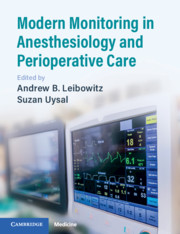Book contents
- Modern Monitoring in Anesthesiology and Perioperative Care
- Modern Monitoring in Anesthesiology and Perioperative Care
- Copyright page
- Contents
- Contributors
- Preface
- Chapter 1 Statistics Used to Assess Monitors and Monitoring Applications
- Chapter 2 Multimodal Neurological Monitoring
- Chapter 3 Cerebral Oximetry
- Chapter 4 The Oxygen Reserve Index
- Chapter 5 Point-of-Care Transesophageal Echocardiography
- Chapter 6 Point-of-Care Transthoracic Echocardiography
- Chapter 7 Point-of-Care Lung Ultrasound
- Chapter 8 Point-of-Care Ultrasound: Determination of Fluid Responsiveness
- Chapter 9 Point-of-Care Abdominal Ultrasound
- Chapter 10 Noninvasive Measurement of Cardiac Output
- Chapter 11 Assessing Intravascular Volume Status and Fluid Responsiveness: A Non-Ultrasound Approach
- Chapter 12 Assessment of Extravascular Lung Water
- Chapter 13 Point-of-Care Hematology
- Chapter 14 Assessment of Intraoperative Blood Loss
- Chapter 15 Respiratory Monitoring in Low-Intensity Settings
- Chapter 16 The Electronic Health Record as a Monitor for Performance Improvement
- Chapter 17 Future Monitoring Technologies: Wireless, Wearable, and Nano
- Chapter 18 Downside and Risks of Digital Distractions
- Index
- Plate Section (PDF Only)
- References
Chapter 4 - The Oxygen Reserve Index
Published online by Cambridge University Press: 28 April 2020
- Modern Monitoring in Anesthesiology and Perioperative Care
- Modern Monitoring in Anesthesiology and Perioperative Care
- Copyright page
- Contents
- Contributors
- Preface
- Chapter 1 Statistics Used to Assess Monitors and Monitoring Applications
- Chapter 2 Multimodal Neurological Monitoring
- Chapter 3 Cerebral Oximetry
- Chapter 4 The Oxygen Reserve Index
- Chapter 5 Point-of-Care Transesophageal Echocardiography
- Chapter 6 Point-of-Care Transthoracic Echocardiography
- Chapter 7 Point-of-Care Lung Ultrasound
- Chapter 8 Point-of-Care Ultrasound: Determination of Fluid Responsiveness
- Chapter 9 Point-of-Care Abdominal Ultrasound
- Chapter 10 Noninvasive Measurement of Cardiac Output
- Chapter 11 Assessing Intravascular Volume Status and Fluid Responsiveness: A Non-Ultrasound Approach
- Chapter 12 Assessment of Extravascular Lung Water
- Chapter 13 Point-of-Care Hematology
- Chapter 14 Assessment of Intraoperative Blood Loss
- Chapter 15 Respiratory Monitoring in Low-Intensity Settings
- Chapter 16 The Electronic Health Record as a Monitor for Performance Improvement
- Chapter 17 Future Monitoring Technologies: Wireless, Wearable, and Nano
- Chapter 18 Downside and Risks of Digital Distractions
- Index
- Plate Section (PDF Only)
- References
Summary
Pulse oximetry was one of the most quickly and widely adopted bedside monitors in the operating room and intensive care unit. Improvements to it over time have increased its reliability and extended its applications. Advanced warning of critical oxygen desaturation, especially during airway management, is a goal of a new pulse oximetry function termed “oxygen reserve index.” This function in its current state of development would alarm when the SpO2 is> 99% and predict the decrease to an SpO2 < 98% in a time frame (e.g., 30–-40 seconds) that might impact management. This chapter reviews this function, the clinical investigations published thus far, and the possible benefits and difficulties in utilizing such an alarm.
- Type
- Chapter
- Information
- Publisher: Cambridge University PressPrint publication year: 2020
References
- 1
- Cited by

